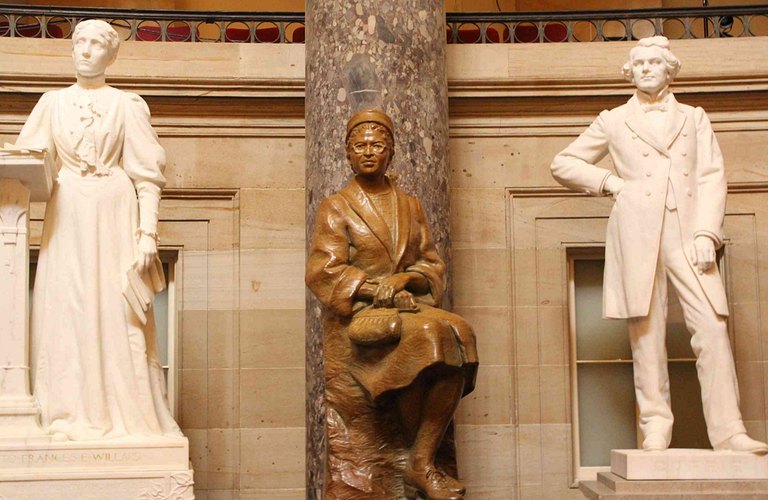A renewed popular interest in identity politics has meant for many that institutional sexism and racism have never before been so widely discussed, yet who of us has stopped to think about the naming conventions of the very street on which you walk, or your neighborhood park, or the statues within it? Rebecca Solnit writes about the gendering of New York City, which is unsurprisingly largely named for aristocratic white men. What if we were to rename our parks, streets, buildings and monuments for the many historical women who haven’t received their fair share of accolades? Read Solnit in partial below, in full with an interactive map via the New Yorker.
As the train rumbles south under Manhattan’s East Side, you might disembark at Hunter College, which, although originally a women’s college, was named after Thomas Hunter, or ride farther, to Astor Place, named after the plutocrat John Jacob Astor, near Washington Square, named, of course, after the President. Or you might go even farther, to Bleecker Street, named after Anthony Bleecker, who owned farmland there, and emerge on Lafayette Street, named after the Marquis de Lafayette. En route you would have passed the latitudes of Lincoln Center, Columbus Circle, Rockefeller Center, Bryant Park, Penn Station—all on the West Side.
A horde of dead men with live identities haunt New York City and almost every city in the Western world. Their names are on the streets, buildings, parks, squares, colleges, businesses, and banks, and their figures are on the monuments. For example, at Fifty-ninth and Grand Army Plaza, right by the Pulitzer Fountain (for the newspaper magnate Joseph Pulitzer), is a pair of golden figures: General William Tecumseh Sherman on horseback and a woman leading him, who appears to be Victory and also a nameless no one in particular. She is someone else’s victory.
The biggest statue in the city is a woman, who welcomes everyone and is no one: the Statue of Liberty, with that poem by Emma Lazarus at her feet, the one that few remember calls her “Mother of Exiles.” Statues of women are not uncommon, but they’re allegories and nobodies, mothers and muses and props but not Presidents. There are better temporary memorials, notably “Chalk,” the public art project that commemorates the anniversary of the 1911 Triangle Shirtwaist Factory fire, in which a hundred and forty-six young seamstresses, mostly immigrants, died. Every March 25th since 2004, Ruth Sergel has coördinated volunteers who fan out through the city to chalk the names of the victims in the places where they lived. But those memories are as frail and fleeting as chalk, not as lasting as street names, bronze statues, the Henry Hudson Bridge building, or the Frick mansion.
A recent essay by Allison Meier notes that there are only five statues of named women in New York City: Joan of Arc, Golda Meir, Gertrude Stein, Eleanor Roosevelt, and Harriet Tubman, the last four added in the past third of a century. Until 1984, there was only one, the medieval Joan in Riverside Park, installed in 1915. Before that, only men were commemorated in the statuary of New York City. A few women have been memorialized in relatively recent street names: Cabrini Boulevard, after the canonized Italian-American nun; Szold Place, after the Jewish editor and activist Henrietta Szold; Margaret Corbin Drive, after the female Revolutionary War hero; Bethune Street, after the founder of the orphan asylum; and Margaret Sanger Square, after the patron saint of birth control. No woman’s name applies to a long boulevard like Nostrand Avenue, in Brooklyn, or Frederick Douglass Boulevard, in northern Manhattan, or Webster Avenue, in the Bronx. (Fulton Street, named after Robert Fulton, the steamboat inventor, is supposed to be co-named Harriet Ross Tubman Avenue for much of its length, but the name does not appear to be in common usage and is not recognized by Google Maps.) No woman is a bridge or a major building, though some may remember that Gertrude Vanderbilt Whitney is the founder for whom the museum is named. New York City is, like most cities, a manscape.
*Image of Washington DC Rosa Parks statue via sojo.net
